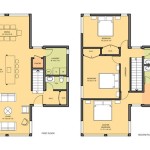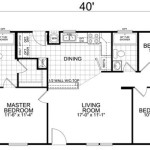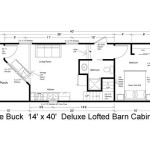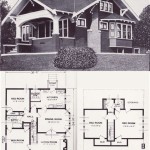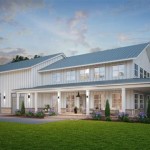One Story House Plans With In-Law Suite: A Comprehensive Guide
The demand for single-story homes with in-law suites continues to rise, driven by aging populations, multi-generational living arrangements, and the desire for flexible housing solutions. These plans offer a blend of privacy and togetherness, allowing families to maintain independence while remaining connected. This article explores the various aspects of one-story house plans with in-law suites, including design considerations, benefits, functional requirements, and legal aspects to consider before moving forward with such a design.
Understanding the Appeal of Single-Story Homes with In-Law Suites
The popularity of one-story house plans with in-law suites stems from a variety of factors. For elderly family members or those with mobility issues, a single-story layout eliminates the challenges posed by stairs. This accessibility is a primary driver for many families choosing this type of design. Furthermore, an in-law suite provides a private and self-contained living space, fostering independence and reducing the potential for conflicts that can arise in shared living spaces. This arrangement can also be financially advantageous, allowing families to pool resources and share expenses, such as mortgage payments and utilities. The ability to have family members close by offers peace of mind, especially when caring for aging parents or assisting adult children as they transition into independent living.
Beyond familial benefits, an in-law suite can serve as a valuable asset in the real estate market. It can increase the property's value and appeal to a wider range of potential buyers. Even if an in-law suite isn't immediately needed for family members, it can be used as a rental unit, generating additional income. This flexibility makes single-story homes with in-law suites a practical and versatile investment for homeowners.
The architectural appeal of single-story homes is also a significant factor. They often blend seamlessly with the surrounding landscape and can be designed in a wide range of styles, from traditional ranch homes to contemporary modern designs. This adaptability allows homeowners to create a visually appealing and functional living space that meets their specific needs and preferences.
Key Design Considerations for One-Story House Plans with In-Law Suites
Designing a one-story house with an in-law suite requires careful planning to ensure both privacy and accessibility. The location of the in-law suite within the overall floor plan is crucial. Ideally, it should be situated at one end of the house, with its own separate entrance. This minimizes disturbances to the main living area and provides the occupants of the suite with a sense of independence.
The size and layout of the in-law suite should be tailored to the specific needs of its occupants. A typical in-law suite includes a bedroom, bathroom, living area, and a kitchenette. The kitchenette should be equipped with essential appliances, such as a refrigerator, microwave, and cooktop, allowing for independent meal preparation. The bathroom should be designed with accessibility in mind, including features such as grab bars, a walk-in shower, and a raised toilet seat. The living area should be comfortable and functional, providing space for relaxation and entertainment.
Accessibility is paramount in the design of an in-law suite. Wide doorways and hallways accommodate wheelchairs and walkers. Smooth, non-slip flooring reduces the risk of falls. Ample lighting is essential to enhance visibility and prevent accidents. Thoughtful design considerations can greatly improve the quality of life for occupants with mobility limitations.
Attention should also be paid to soundproofing. Walls and floors separating the in-law suite from the main living area should be adequately insulated to minimize noise transfer. This ensures privacy and reduces potential disturbances for both occupants.
The integration of the in-law suite with the overall design of the house is essential. The architectural style and materials used in the suite should complement the rest of the house, creating a cohesive and harmonious aesthetic. Landscaping can also play a role in enhancing the privacy of the in-law suite, with strategically placed shrubs and trees providing visual separation from the main living area.
Functional Requirements and Amenities for In-Law Suites
Beyond the basic elements of a bedroom, bathroom, living area, and kitchenette, several other functional requirements and amenities should be considered when designing an in-law suite. Adequate storage space is essential for maintaining an organized and clutter-free living environment. Built-in closets and shelving can maximize space and provide ample storage for clothing, personal belongings, and household items.
A separate laundry area, even if it's a compact space with a stacked washer and dryer, can significantly enhance the independence of the in-law suite. This eliminates the need for occupants to share laundry facilities with the main household, providing greater convenience and privacy.
Climate control is another important consideration. The in-law suite should have its own thermostat, allowing occupants to adjust the temperature to their preference. This ensures comfort and prevents potential conflicts over temperature settings.
Internet access and cable television are essential amenities for modern living. The in-law suite should be wired for internet and cable, providing occupants with access to entertainment, communication, and information.
Outdoor space, such as a patio or deck, can greatly enhance the enjoyment of the in-law suite. This provides occupants with a private outdoor area for relaxation, gardening, or entertaining guests.
Security features, such as a separate alarm system or security cameras, can provide peace of mind for both occupants of the in-law suite and the main household. This enhances safety and security, especially for elderly or vulnerable individuals.
Integrating universal design principles throughout the in-law suite can further enhance its accessibility and usability for people of all ages and abilities. This includes features such as lever-handled door hardware, rocker-style light switches, and adjustable-height countertops.
Legal and Code Considerations for In-Law Suites
Before embarking on the construction of a one-story house with an in-law suite, it is essential to research and comply with all applicable local zoning regulations, building codes, and homeowners association (HOA) rules. Zoning regulations often dictate the permissible uses of a property, including whether or not an accessory dwelling unit (ADU) or in-law suite is allowed. Building codes specify the minimum standards for construction, ensuring safety and structural integrity. HOA rules may impose additional restrictions on the design and use of in-law suites.
In many jurisdictions, an in-law suite is considered an ADU, which is defined as a self-contained living unit located on the same property as a primary dwelling. ADUs are subject to specific regulations regarding size, setbacks, parking, and utilities. Failure to comply with these regulations can result in fines, legal action, or even the demolition of the in-law suite.
It is also important to consider the potential impact of an in-law suite on property taxes. In some jurisdictions, adding an in-law suite may increase the assessed value of the property, resulting in higher property taxes.
Rental regulations may also apply if the in-law suite is intended to be used as a rental unit. Landlord-tenant laws govern the rights and responsibilities of landlords and tenants, and it is important to comply with these laws to avoid legal disputes.
It is advisable to consult with a qualified attorney or real estate professional to ensure compliance with all applicable laws and regulations before proceeding with the construction of an in-law suite.
The process of obtaining the necessary permits for building an in-law suite can vary depending on the location. Typically, this involves submitting detailed architectural plans to the local building department for review. The plans must comply with all applicable building codes and zoning regulations. Once the plans are approved, building permits will be issued, allowing construction to begin.
Regular inspections are typically conducted during the construction process to ensure compliance with the approved plans and building codes. These inspections may cover aspects such as structural integrity, electrical wiring, plumbing, and HVAC systems.
Obtaining a certificate of occupancy is the final step in the process. This certificate confirms that the in-law suite has been built in accordance with all applicable codes and regulations and is safe for occupancy.
By carefully researching and complying with all applicable laws and regulations, homeowners can ensure that their one-story house with an in-law suite is a legally compliant and valuable addition to their property.

House Plan 65862 Tuscan Style With 2091 Sq Ft 3 Bed 2 Bath 1

Homes With Mother In Law Suites

One Story With In Law Suite Plan 2286

In Law Suite Plans Give Mom Space And Keep Yours The House Designers

Impressive Home Plans With Inlaw Suites 8 House In Law Suite Floor Modular One Story Multigenerational

5 Bedroom Ranch House Plan With In Law Suite 2875 Sq Ft

House Plans With In Law Suites Houseplans Blog Com

Impressive One Level Modern Farmhouse With In Law Suite 12315jl Architectural Designs House Plans

Front Side View House Plans With A Separate In Law Suite

Pin On Dream Home


